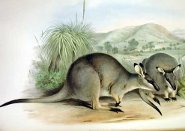 The Western brush wallaby (Macropus irma), which is also known as the black gloved wallaby, is an attractively marked marsupial that can be found in Australia. Like other wallabies, the Western brush wallaby resembles a small kangaroo. It has large, powerful hind legs, a long tail, and small forelegs.
The Western brush wallaby (Macropus irma), which is also known as the black gloved wallaby, is an attractively marked marsupial that can be found in Australia. Like other wallabies, the Western brush wallaby resembles a small kangaroo. It has large, powerful hind legs, a long tail, and small forelegs. With a total length of 1200mm or about four feet, it is not a very big animal. This wallaby's tail is approximately 720mm or a little more than two-feet long. The Western brush wallaby weighs, on average, approximately 8.0 kg, or about 17.5 pounds.
This coloring of this animal ranges from a light to a medium gray. The Western brush wallaby's most noticeable attributes are its striking markings, which include distinctive white facial stripes, black tipped ears, and black hands and feet. The latter markings are why the Western brush wallaby is sometimes also referred to as the black gloved wallaby.
Western brush wallabies can be found in the southwestern portion of the state of Western Australia. Its main range lies from north of Kalbarri to Cape Arid. This marsupial prefers to live in open forest, woodlands and open plains with low grasses. It can also be found in heathland, areas with low scrubby shrubs. It does not like to live in forests with thick undergrowth.
The Western brush wallaby is a grazer and feeds on grass. It mainly feeds during the cooler parts of the day, in the early mornings or late afternoons. Though it is not a nocturnal animal, it does rest during the hotter part of the day in the shade.
For the most part, the Western brush wallaby is a solitary animal, though it can sometimes be spotted in pairs. Little is known about its breeding season or habits, but Western brush wallabies give birth in either April or May. The babies live in their mothers' pouches for around six months, before emerging around October or November.
When settlers first came to Australia, the Western brush wallaby was a common species. Unfortunately, for a number of years during the 1970s, their numbers declined dramatically, as the non-native red fox decimated its population. Today, fortunately, the red fox population has been reduced, which has allowed the Western brush wallaby's population to rebound.
Currently, the Western brush wallaby is listed as being a species of least concern on the IUCN list, as its numbers appear to be stable. Although its population is considered safe for now, the Western brush wallaby still has a number of enemies, including the fox, wild dogs, and even cats. Though the Western brush wallaby is a protected animal, it is believed that illegal hunting has also taken a toll on the species. Loss of habitat is yet another threat to the Western brush wallaby.
Keywords: black , red , white , diurnal
The Western brush wallaby, western bush wallaby is listed as Near Threatened (LR/nt), is close to qualifying for or is likely to qualify for a threatened category in the near future, on the IUCN Red List of Threatened Species
Countries
AustraliaWestern brush wallaby habitats
Dry savanna, Savanna, Shrubland and Subtropical / Tropical Dry Shrubland
Custom Search